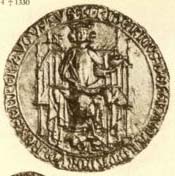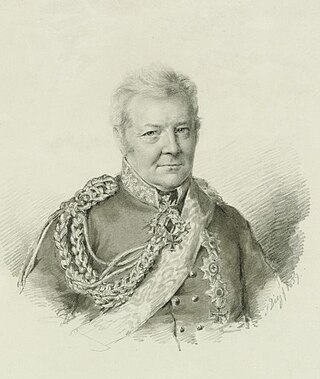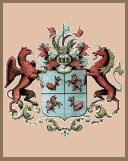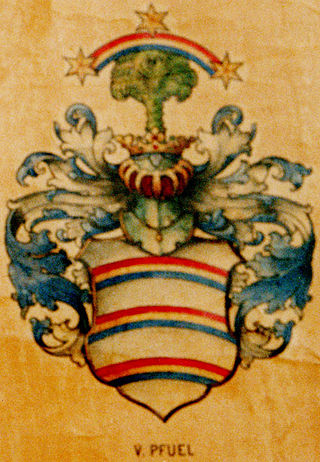Related Research Articles

Frederick William was Elector of Brandenburg and Duke of Prussia, thus ruler of Brandenburg-Prussia, from 1640 until his death in 1688. A member of the House of Hohenzollern, he is popularly known as "the Great Elector" because of his military and political achievements. Frederick William was a staunch pillar of the Calvinist faith, associated with the rising commercial class. He saw the importance of trade and promoted it vigorously. His shrewd domestic reforms gave Prussia a strong position in the post-Westphalian political order of Northern-Central Europe, setting Prussia up for elevation from duchy to kingdom, achieved under his son and successor.

John II was Elector of Brandenburg from 1486 until his death, the fourth of the House of Hohenzollern. After his death he received the cognomen Cicero, after the Roman orator of the same name, but the elector's eloquence and interest in the arts is debatable.

Frederick was the last Burgrave of Nuremberg from 1397 to 1427, Margrave of Brandenburg-Ansbach from 1398, Margrave of Brandenburg-Kulmbach from 1420, and Elector of Brandenburg from 1415 until his death. He became the first member of the House of Hohenzollern to rule the Margraviate of Brandenburg.

Brandenburg-Prussia is the historiographic denomination for the early modern realm of the Brandenburgian Hohenzollerns between 1618 and 1701. Based in the Electorate of Brandenburg, the main branch of the Hohenzollern intermarried with the branch ruling the Duchy of Prussia, and secured succession upon the latter's extinction in the male line in 1618. Another consequence of intermarriage was the incorporation of the lower Rhenish principalities of Cleves, Mark and Ravensberg after the Treaty of Xanten in 1614.

Wilhelm Egon von Fürstenberg-Heiligenberg was a German count and later prince of Fürstenberg-Heiligenberg in the Holy Roman Empire. He was a clergyman who became bishop of Strasbourg, and was heavily involved in European politics after the Thirty Years' War. He worked for the Archbishop-Elector of Cologne and Louis XIV of France at the same time, and was arrested and tried for treason for convincing the Elector to fight on the opposite side of a war from the Empire.

Frederick the Fair or the Handsome, from the House of Habsburg, was the duke of Austria and Styria from 1308 as well as the anti-king of Germany from 1314 until 1325 and then co-king until his death.

Huysburg is a Benedictine monastery situated on the Huy hill range near Halberstadt, in the German state of Saxony-Anhalt. The Romanesque abbey has existed since about 1080 and was secularised in 1804. A new Benedictine community was founded in 1972 and has been headed by a prior since 1984.

Elizabeth Charlotte of the Palatinate was an Electress consort of Brandenburg as the wife of George William, Elector of Brandenburg and Duke of Prussia, and the mother of Frederick William of Brandenburg, the "Great Elector".

The Margraviate of Brandenburg was a major principality of the Holy Roman Empire from 1157 to 1806 that played a pivotal role in the history of Germany and Central Europe.

Karl Friedrich von dem Knesebeck was a Prussian field marshal and military adviser in the Napoleonic Wars, best known for designing the campaign plan of the Battle of the Nations and the subsequent invasion of France. As aide-de-camp to the king from 1813, and thereby his closest military advisor, he was a key figure in Prussia's military policy throughout the War of the Sixth Coalition and the subsequent Congress of Vienna.

Knesebeck most often refers to:

Adam Graf von Schwar(t)zenberg was a German official who advised George William, Elector of Brandenburg, during the Thirty Years' War and served as the Master of the Johanniterorden, the Bailiwick of Brandenburg of the Order of Saint John (1625−41).

The Pfuel family is an ancient German noble family that arrived to Brandenburg in the year 926 and later widened their influence to Saxony, Saxony-Anhalt, Mecklenburg, Pomerania, Württemberg, Westphalia, Eastern Europe and Sweden.

The House of Alvensleben is an ancient, Low German (niederdeutsch) noble family from the Altmark region, whose earliest known member, Wichard de Alvensleve, is first mentioned in 1163 as a ministerialis of the Bishopric of Halberstadt. The family name derives from Alvensleben Castle. They are one of the oldest extant German aristocratic families.
Frederick III of Brandenburg, nicknamed the Fat, also the Younger was Margrave of Brandenburg and Lord of the Altmark.

Peter Christian Breuer was a German sculptor.

The House of Knesebeck is the name of two branches of a prominent aristocratic family in the tradition of the ancient nobility in Germany. In the 17th century they acknowledged a common ancestry and combined their arms. The black line of the family von dem Knesebeck stems from the ancient nobility of Lower Saxony, while the white line stems from the ancient nobility of the Altmark. Branches of both lines remain to this day. As one of the leading Prussian Junker families, it has produced numerous senior military and public figures. These have included ambassadors, bishops, governors, members of parliament, a field marshal, and dozens of generals.
Thomas von dem Knesebeck (1559–1625) was a Privy Councillor and Landeshauptmann (governor) of the Altmark. Together with his father and grandfather he was a major figure in the introduction of Protestantism to Brandenburg.
Thomas von dem Knesebeck may refer to:

Busso VII von Alvensleben was the Burgherr (Lord) of Kalbe, Chief Marshall and Stadtholder of Mark Brandenburg, and Landeshauptmann of Altmark.